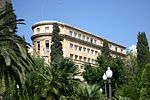Battle of Cissa
210s BC conflicts218 BCBattles in CataloniaBattles involving the Roman RepublicBattles of the Second Punic War

The Battle of Cissa was part of the Second Punic War. It was fought in the fall of 218 BC, near the Celtic town of Tarraco in north-eastern Iberia. A Roman army under Gnaeus Cornelius Scipio Calvus defeated an outnumbered Carthaginian army under Hanno, thus gaining control of the territory north of the Ebro River that Hannibal had just subdued a few months prior in the summer of 218 BC. This was the first battle that the Romans had ever fought in Iberia. It allowed the Romans to establish a secure base among friendly Iberian tribes, and due to the eventual success of the Scipio brothers in Spain, Hannibal looked for but never received reinforcements from Spain during the war.
Excerpt from the Wikipedia article Battle of Cissa (License: CC BY-SA 3.0, Authors, Images).Battle of Cissa
Plaça Corsini, Tarragona
Geographical coordinates (GPS) Address Nearby Places Show on map
Geographical coordinates (GPS)
| Latitude | Longitude |
|---|---|
| N 41.1157 ° | E 1.2496 ° |
Address
Piscolabis
Plaça Corsini 3
43001 Tarragona
Catalonia, Spain
Open on Google Maps









